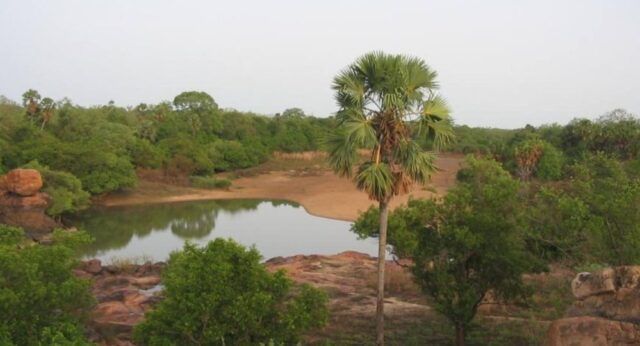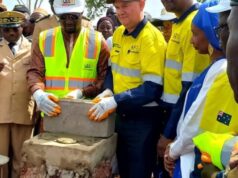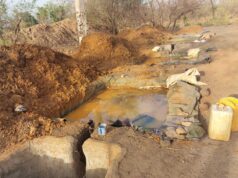The impact of climate change on the African continent is legion, but it is likely to get worse as countries need to develop. The exploitation of mineral resources to create wealth and finance development is one of the aggravating factors. Some of the identified mineral resources are found in and around protected areas, and their destruction through exploitation is a threat to the climate. In Benin, there are still fears, while in Burkina Faso the damage has already been done. Our investigation, as part of the global Open Climate Reporting Initiative (OCRI) project, reveals the climate risks associated with mining in and around protected areas.
In 2013, Benin listed the mineral resources available in its soil. The list is extensive. According to the Beninese Ministry of Mines, between 2013-2014 the country initiated and financed airborne geophysical coverage of the entire territory. This work highlighted several anomalous areas that will serve as targets for future geological and mining prospecting. This work also enabled the magnetic and radiometric susceptibility of the geological formations and structures and the gradio-gravimetry of the coastal sedimentary basin to be assessed. The results of this work have made it possible to provide the country with reliable geological data and information.
As a result of this study, and many others carried out in the same vein, it was found that the country has several deposits of mineral resources. Most of these identified resources are deposits of gold, phosphate, uranium, tin, ornamental stones and construction materials. The country intends to exploit these resources and, in the process, has opened the floodgates for investors from all over the world to come forward for this almost virgin mining potential, as there are only a few artisanal or semi-industrial operations that are not very advanced. From then on, things began to get complicated for the environment and especially for the climate. Some of the listed deposits encroach on areas considered to be protected areas, which are home to classified forests and other forms of biodiversity.
Mining in the Sahel reserve in Burkina Faso
Unlike Benin, Burkina Faso has a long history of mining. The Sahel region in the north of the country was home to three industrial mines: Inata, Tambao and Essakane. While the Inata and Tambao mines are closed, the Essakane mine is still in operation. These three mines have one thing in common. They are all illegal under the decree classifying the Sahel sylvo-pastoral and partial wildlife reserve, adopted on 9 November 1970 by the Council of Ministers of the Republic of Upper Volta.
The Sahel Silvopastoral and Partial Wildlife Reserve is special in that it includes towns such as Dori, Djibo, Gorom-Gorom, Sebba. The area has a long tradition of gold panning. Indeed, the Essakane goldfield was discovered in 1985 by farmers. Faced with the scale of the gold rush and the apparent wealth of the site, the government created the “gold panning project” to supervise artisanal miners. In 1999, the government created, with the Engineering and export development company (SIREX), the Gold mining company in Burkina (CEMOB), to launch semi-mechanised mining in addition to the artisanal gold panning already practised.
But despite these various manoeuvres, industrial mining, like artisanal gold panning, is an activity that does not comply with its status. The International Union for Conservation of Nature (IUCN) had already sounded the alarm in a study published in 2009.
According to the Director General of the National Office of Protected Areas (OFINAP), Benoit Doamba, when a forest is classified, there are usage rights, but mining cannot be one. «If it is necessary to declassify a few hectares and make an enclave to exploit mining resources and save protected areas, this is possible, but with full responsibility and knowledge of the facts. The way things are going in the Sahel is a serious precedent, a serious jurisprudence,» the director of the office continues.
The exploitation permits issued within the Sahel Reserve violate Article 120 of the 2015 Mining Code which states that «prospecting, research or exploitation of mineral substances may not be undertaken on the surface, at depth or in the vicinity of a protection zone, (…)».
Important biodiversity for West Africa
Estimated at 1,822,600 ha, according to the latest assessments by the Ministry of Environment, Energy, Water and Sanitation, the Sahel Reserve is an important area for West African biodiversity. It is home to 3 RAMSAR sites (a RAMSAR site is the designation of a “wetland of international importance” that records the presence of vulnerable species). These are the Oursi, Yomboli and Darkoye ponds which are refuges for migratory birds. They are also home to fully protected species such as the carrion vulture and the white-headed vulture.
The Director of OFINAP also mentions the presence of mammals such as gazelles, certain species of hyenas, notably the spotted hyena, jackals and other species of carnivores, not to mention the Gourma elephants that return from Mali at the beginning of each winter season to take advantage of the area’s pastures. Located in the extreme north of Burkina Faso, the reserve has an arid, very hot climate with the lowest rainfall in the country, hence its fragility.
«It is a vast area, but it is fragile because of the water problem. It is true that the trend is to drill boreholes to improve people’s living conditions, but it is necessary to find ways to preserve biodiversity,» says Benoit Doamba. “It is important to conserve biodiversity, because it is the very basis of life. At the international level, the IUCN classifies the Sahel Silvopastoral and Partial Wildlife Reserve as one of the large protected areas in West Africa located in arid zones.
Importance of protected air for the climate
According to a study by the International Union for Conservation of Nature (IUCN), The Nature Conservancy, the United Nations Development Programme (UNDP), the World Bank, and WWF, protected areas offer a cost-effective solution to combat the effects of climate change. The study argues that protected areas store 15 per cent of the world’s terrestrial carbon stock, or 312 Gigatonnes.
They also «serve as natural protection against climate impacts and other natural disasters, providing space to disperse rainwater, stabilise soils to prevent landslides and stop storm surges. Finally, protected areas help to keep natural resources healthy and productive so that they can withstand the impacts of climate change».
Referring to the great importance of protected areas of all kinds for the climate, the Director General of Environment and Climate in Benin, Professor Martin Pépin Aïna, «protected areas are actually natural carbon traps that regulate the balance of greenhouse gas emissions; they are like a carbon stock”. The expert goes on to explain that “the other importance of protected areas is that they protect biodiversity. And when there is this balance, it creates a microclimate and in this case we talk more about territorialisation (…) We must also mention all the ecosystem services that these areas provide to the population».
It goes without saying that the destruction of these natural jewels would pose a huge danger to the climate. Mining often takes precedence over the preservation of protected areas because states consider mining resources to be more economically profitable, and therefore natural areas that are supposed to be protected are downgraded and destroyed.
«Marine and coastal ecosystems, such as mangroves, wetlands and seagrass beds, which play an important role in absorbing CO2, providing coastal protection from sea level rise and supporting economic activities such as fishing and tourism, are being lost at an alarming rate and the extent of marine protected areas is less than 1 per cent of the ocean’s surface,» says Imèn Meliane, Senior Marine Policy Advisor at The Nature Conservancy, quoted in the study report.
According to Professor Pépin Aïna, it would be disastrous for the climate to destroy protected areas. «The destruction of these protected areas is a big threat to the climate because there will no longer be a carbon trap and therefore no longer any regulation of greenhouse gas emissions, which inevitably leads to the gradual destruction of the ozone layer. This process will result in the disruption of the climate cycle and we could see all kinds of natural disasters,» he said. This implies that global climate change is largely the result of human industrial and mining activities.
Protected areas threatened by mining in Benin
In the north-east of Benin, in the department of Alibori, a protected area is threatened by mining operations. It is a forest classified by decree n°6459/SE of 18 August 1955. With an area of approximately 256,000 hectares, the equivalent of 32 times the surface area of the city of Cotonou, this forest located in the upper part of the Alibori department is home to considerable biodiversity and helps maintain the climate cycle. However, it is threatened by mining. Indeed, near the forest, gold and tin deposits have been discovered. Even if tin is not a priority for the state, it must be said that gold is the focus of interest. This is causing a great deal of concern among biodiversity conservationists.
Other protected areas in the country are equally at risk. This is the classified forest of the three rivers, where gold sites have been identified in and around it. Located in Kalalé in the north-east of Benin, this forest covers an area of 259,500 ha, equivalent to 23 times the size of the commune of Porto-Novo, which is the political capital of Benin, and plays an important role in protecting hundreds of wild species.
The W-Arly-Pendjari Complex (WAP), Benin’s most important protected site and a UNESCO World Heritage Site, is not spared from the threats posed by the future industrial exploitation of mining resources in Benin. According to the UN organisation, the WAP is the largest and most important continuum of terrestrial, semi-aquatic and aquatic ecosystems in the West African savannah belt. It provides a refuge for animal species that have become extinct elsewhere in West Africa or are highly threatened. It is home to the largest population of elephants in West Africa and most of the region’s typical large mammals, such as the African manatee, cheetah, lion and leopard.
UNESCO also considers on its platform that the WAP Complex benefits from long-term legal protection conferred by national legislation and receives financial and technical support from States and some development partners. However, despite this legal protection of this immense protected area, Benin has authorised mining exploration, which has led to the discovery of phosphate and iron, two mineral resources that are high on the government’s list of industrial exploitation priorities.
Mining as a major producer of greenhouse gases
Mahamady Porgo and Orhan Gokyay from the University of Marmara in Turkey showed in a study published in 2017 on «Environmental impacts caused by the exploitation of the Essakane gold mine», that the exploitation of the mine contributes directly or indirectly to air pollution in the Essakane district. «The use of chemicals such as cyanide (industrial gold mining) and mercury (artisanal gold mining) to extract gold from the ore is a potential risk to the ecosystem, the health of the local population and livestock production,» the study said. It also found that there is «significant degradation of the natural landscape and topography of the land by open pit mining (industrial mining) and holes dug by artisanal miners».
In the report on «Deforestation and forest degradation in Burkina Faso: current trends and main drivers», carried out in 2019 by the Forest Investment Programme (FIP), the experts carried out a quantitative analysis of the quantitative impacts of mining on the evolution of forests and greenhouse gas emissions in general and carbon emissions/sequestration, considering fuel consumption and indirect deforestation. At the end of their analysis, they concluded that an industrial gold mine in Burkina produces 543 tonnes of CO2 emissions per ounce of gold per month.
These various studies raise questions about the respect of the commitments made by mining companies for the protection of the environment in their environmental and social management plans. In Burkina Faso, the National Environmental Assessment Agency (ANEVE) is the structure responsible for monitoring and supervising the implementation of mining companies’ environmental management plans. According to ANEVE officials, no management plan monitoring missions have been carried out in mining companies since 2018 due to insecurity. Among the shortcomings observed with regard to environmental protection, ANEVE highlights, among other things, the absence of a system for recovering water from wastewater treatment plants, the failure to assess the rate of reforestation and the burial of recoverable and hazardous waste.
Towards an environmental and climate disaster in Benin!
Mining in Benin is still at an embryonic stage, although some artisanal and semi-industrial mining is taking place in the north in the Atacora department. The damage already caused by these small-scale operations raises the spectre of what awaits the country if industrial exploitation takes hold. The artisanal miners alone cause great environmental degradation due to the holes they dig and also the chemicals such as mercury they use for their work.
According to the Beninese Office of Geological and Mining Research (OBRGM), the Beninese government, in its mining policy, wants to focus on gold, lithium, ornamental stones and construction materials. These deposits are in abundance, but some are very close to and even in the heart of protected areas. According to Julien Houndolo, an expert in development, decentralisation and risk management, «the law on the protection of protected areas will not protect these areas from the exploitation of mines and minerals because the state cannot prohibit itself from doing certain things that would allow it to generate financial resources for the good health of the economy, given that it is the state itself that will still take the law for exploitation…».
And yet, Article 16 of the law on protected areas in the Republic of Benin states that ‘the integral nature reserve is an area preserved to allow the free play of natural factors without any external intervention, with the exception of safeguard measures necessary for the very existence of the reserve. All forms of hunting and fishing, all forestry, agricultural and mining exploitation, all grazing and clearing, all excavations and prospecting, all soundings, earthworks and constructions, all work tending to modify the appearance of the land or vegetation, all polluting or harmful activities, all introduction of animal or plant species and, in general, all acts likely to harm or disturb the fauna or flora are prohibited throughout the integral nature reserves. Unless special authorisation is given by the Minister responsible for wildlife, it is forbidden to carry out any scientific research in the integral nature reserves, as well as to enter, circulate, camp, reside or fly over them at low altitude.
For Martial Kouderin, President of CREDI ONG, the legal provisions for the safeguarding of protected areas are rather weak. «There are many legal frameworks that have been developed to regulate or protect natural areas, but not always enough because there are some areas, notably community areas that are not sufficiently protected legally,» he said. «Generally, operators do not carry out environmental impact studies or they botch them,» he said. «They (the operators – Editor’s note) don’t manage to calculate all the ecosystem services (of the protected areas – Editor’s note) and that’s what makes mining more profitable than conserving biodiversity.»
This article was written by Modeste Dossou (Benin), Pesce Hounyo (Benin), Nadège Yé (Burkina Faso) and Yvette Zongo (Burkina Faso), within the framework of the project “West Africa facing climate change ” with the support of CENOZO.










